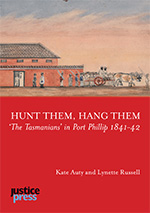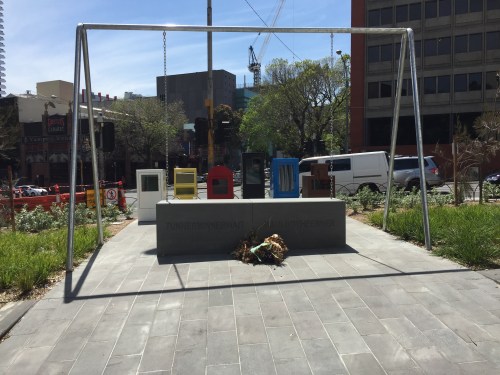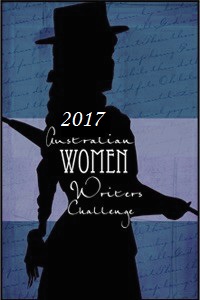
2016, 78 p.
This slim book of 78 pages stands in its own right as the account of a historical incident – that of the execution of Tunnerminnerwait and Maulboyheener in Melbourne on 20 January 1842- but it is also (and perhaps more importantly) a contribution to the present-day debate over marking and commemorating the frontier wars in Port Phillip.
First- some background. In 2016 the City of Melbourne launched a public memorial to Tunnerminnerwait and Maulboyheener on the corner of Franklin and Victoria Streets in Melbourne, close to where the two men were executed on 20 January 1842. This was the culmination of a long campaign by activist Joe Toscano, who had been marking the anniversary of the execution of these two ‘freedom fighters’ over many years. In laying the ground work for this memorial, the City of Melbourne commissioned a booklet by Claire Land available at http://www.melbourne.vic.gov.au/SiteCollectionDocuments/tunnerminnerwait-and-maulboyheenner.pdf .

[Image attribution: By Canley (Own work) [CC BY-SA 4.0 (http://creativecommons.org/licenses/by-sa/4.0)%5D, via Wikimedia Commons]
In response to this proposal for a memorial, historian Marie Fels, former Aboriginal Affairs Victoria heritage operations manager David Clark and Mornington Peninsula local historian Rene White published an article in Quadrant magazine titled ‘Mistaken Identity, Not Aboriginal Heroes’ available at https://quadrant.org.au/magazine/2014/10/mistaken-identity-aboriginal-resistance/ . In speaking out against the proposal to commemorate Tunnerminnerwait and Maulboyheener, they wrote:
Our problem with it is that it is history-lite, based mainly on secondary sources, with little primary research. It reads as an argument that Tunnerminnerwait and Maulboyheenner were resistance fighters deserving of memorialisation. Our research, based only on primary sources, demonstrates conclusively that they were not resistance fighters: on their own personal testimony, they shot and killed two whalers by mistake.
I have reviewed Marie Fels’ work previously (here and here) and I have seen her described as one among a number of ‘benignist’ historians who, while not denying settler violence and injustice towards indigenous people, also point to co-operative strategies between settlers and indigenous people in early frontier history. The journal in which their article appears, Quadrant, is a right-wing publication which strongly supported Keith Windschuttle when he accused historians of ‘fabricating’ aboriginal history. An interview with Fels, Clark and White reported in a Frankston local newspaper notes that when they had difficulty in having their criticisms of the Melbourne City Council memorial publicized (most particularly in the Age) they turned to Quadrant which, perhaps not surprisingly, took up their article with alacrity.
This, then, is the context in which Hunt Them, Hang Them has been published. The authors, Kate Auty and Lynette Russell, note Fels’ public opposition to the City of Melbourne commemoration, on the basis that Tunnerminnerwait and Maulboyheener were convicted on the basis of ‘their own personal testimony‘. In making their own argument they claim:
The events outlined here are just one part of an unfolding tragedy- race relations and the judicial process in Australia. The ultimate question is whether these men received a fair trial and whether they should be memorialised. We answer ‘no’ and ‘yes’. (p.7)
In making this argument, they delve deeply into the details of the arrest and trial of the Tasmanian prisoners. In particular, they raise questions about the manner of the arrest of ‘The Tasmanians’, an event I described in my ‘This Week in Port Phillip’ entry for 25-30 November 1841. They ask why the Assistant Aboriginal Protector William Thomas, who was present at the arrest, was not called at the trial, and raise questions about the ‘admissions’ of guilt. They question whether Judge Willis was biassed, most particularly in his decision to force the trial in the absence of an important witness and against the application of the prosecutor, and they ask whether there was a conflict on interest on behalf of their legal counsel, Redmond Barry.
Their argument is framed very much within a consciousness of the intertwining of Port Phillip and Van Diemen’s Land history, an awareness strongly reinforced by Lynette Russell’s earlier work on sealers and whalers along both sides of the Bass Strait (see my review of Roving Mariners). They note that Tunnerminnerwait and Maulboyheener were part of a ‘family’ (loosely defined) of indigenous Tasmanians brought over by Aboriginal Protector George Augustus Robinson, who had made his reputation as a ‘conciliator’ in Tasmania.
The opening chapter begins with a description of the historical actors most pertinent to the trial: George Augustus Robinson, who they (along with many others) portray as a vain social climber; the vainglorious and unpredictable Judge John Walpole Willis (a view I also share) and mineowner William Watson, the shadowy ‘charlatan and liar , the only witness called during the trial.
Chapter Two ‘Context, conflict, cases, confessions’ describes the frontier resistance with the ‘settlement’ of Port Phillip, fraudulently presented by John Batman (another Tasmanian) as a consensual, treaty-driven process. In particular, they look to Major Lettsom’s ‘dispersal’ of ‘Goulburn black’ men, women and children, a little over a mile from Melbourne in late 1840. This action, involving 58 armed troopers, culminated in the death of two indigenous men and the wounding of another, and the detention of 300 people in the Melbourne stockade. A dozen indigenous men were charged and nine were sentenced to ten years transportation. This occurred prior to Judge Willis’ arrival in Melbourne, and he overturned all the verdicts on a technical miscarriage of justice. However, Willis’ findings in other cases highlight the unpredictability of Willis’ stance in indigenous cases. The authors correctly identify Willis’ direction that his neighbour Bolden be acquitted as an important factor, occurring almost simultaneously with the Tasmanians’ trial.
Chapter Three ‘Hunting stories’ triangulates the accounts of three of the men involved in the pursuit of the Tasmanians in different capacities: the journals of William Thomas and George Augustus Robinson as Aboriginal Protectors (albeit with professional differences in approach), and military ensign Mayor Rawson who wrote an undated account ‘ Journal of an expedition after some Van Diemen’s Land Blacks who were committing depredations at Western Port on the Southern Coast of New Holland October and November 1841.’ As well as highlighting the bumbling farce that the pursuit became, they remind us that this occurred during the visit of Governor Gipps- an important event for Port Phillip pride and identity.
Chapter Four ‘The Dispersal- a thrice-told tale’ again takes the approach of triangulating three accounts: those of Frederick Powlett, the Commissioner of Lands and J.P. responsible for the Border Police contingent, Ensign Rawson as one of the military troops involved in the pursuit, and the Assistant Protector William Thomas. The discrepancies between their accounts are most pertinent in the varying accounts they gave of ‘Truganini and the grave’ in Chapter Five where, along with the evidence of Corporal Johnson of the Border Police, there are different opinions over whether or not Truganini took her captors to the grave of the murdered men and ‘admitted’ the murders and the varying involvement of the indigenous men and women who were now being charged.
Chapter Six traces through the committal before a bench of magistrates, which was attended by Judge Willis, a permissable but unconventional practice that he undertook, claiming oversight of all justice in the Port Phillip District as its only resident Supreme Court Judge. Moving on to the Supreme Court trial in Chapters Six and Seven, Auty and Silver stress the significance of the absence of three important witnesses who were present for the committal but not the Supreme Court trial. In particular, they ask why and by whom Assistant Protector Thomas was prevented from attending – a point now revealed by the recent and very valuable (but prohibitively expensive) publication of Thomas’ journals by Marguerite Stephens. They highlight the inappropriate interaction between George Augustus Robinson and Judge Willis, and Willis’ indulgence of sloppy testimony from Commission of Lands Powlett, (especially in the light of the lambasting he had recently given Aboriginal Protector Charles Sievewright in the Bolden case). The authors suggest that Willis may have been smarting under the criticism of George Arden from the Port Phillip Gazette, but as I have shown through several This Week in Port Phillip postings, Willis well and truly had Arden’s measure. I don’t dispute that Willis was very aware that this was a ‘hot-button’ case, but he didn’t need Arden to tell him that. They finish their book with a brief description of the hanging.
Have they convinced me about the shortcomings of the trial? Yes- most particularly in regard to Assistant Protector Thomas’ absence, who would have provided a completely different angle. In other cases where Willis had an interest in seeing a particular outcome- in the case he heard against Bolden, for example- he would have picked and picked until it all unravelled. But Auty and Russell, along with Claire Land in the Melbourne City Council publication, sidestep the issue that Fels has emphasized: that two whalers were murdered. The Tasmanians admitted this, and said that it was a case of mistaken identity because they intended retribution against William Watson instead.I think that the jury understood this, whatever the shortcomings of the trial. I have always been struck by Willis’ rejection of the jury’s recommendation to mercy when he called for the death penalty, to which Gipps agreed.
Auty and Russell’s argument for memorialization is based on the insufficiencies and failures of the trial:
This case is tainted. It unfolded at a time when ‘near enough was good enough’ for Aboriginal people in legal settings. We no longer should accept that reasoning. If there is a memorial to Redmond Barry, a street and a river named for Powlett, an inlet named for Anderson, a creek named for Watson and a town named for Rawson, then Tunnerminnerwait and Maulboyheener should have their own travails recognized. (p.73)
While they have convinced me about the shortcomings of the trial, I’m not convinced that they should be memorialized for this alone. I should imagine that this justification would rankle with Fels, Clarke and White too, who suggest that Winberri, who was shot in Major Lettsom’s raid is a far more fitting “Melbourne hero” to merit a memorial. For myself, I have never been comfortable with the ‘freedom fighter’ frame that has been placed on this episode- a point well made in the Fels article.

Whatever my reservations about the design of this memorial (and yes, I do have reservations), I absolutely love the image of the Wurundjeri elder, Barak, that has been shaped out of the white building behind.
[Image attribution: By Leighblackall (Own work) [CC BY-SA 3.0 (http://creativecommons.org/licenses/by-sa/3.0)%5D, via Wikimedia Commons]

I am posting this review to the Australian Women Writers Challenge page. In a way, it’s a 3-for-1 review, because all three texts that I have mentioned in this review are written by women, which is in itself interesting. I strongly suggest that you dip into all three. Hunt Them, Hang Them is available for $28.95 through Justice Press, while Fels’ Quadrant article is available here, and Claire Land’s City of Melbourne booklet is here. Auty and Russell’s book and Fels’ article both draw heavily on primary sources, and there is much commonality between them until the political implications are drawn out. Even if you just read the two online sources, you’ll see historians at work, raising good questions about the rationale and impetus for memorializing in the present-day.

Ned Kelly and Breaker Morant all over again. The apologists overlook that murder was done.
That these events happened in the 19th century certainly changes the historical context in which they were judged. But whatever the merits or failings of legal issues, we can see yet again the gross immorality of capital punishment. Even the jury asked for mercy… which Judge Willis chose to ignore.